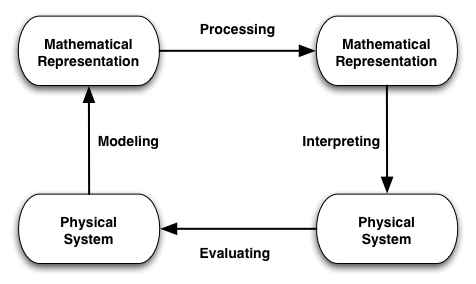A critical element is how meaning in physics is mapped into and interpreted via mathematical structures. We identify the elements of this process via the following diagram:

We begin in the lower left with some "things of physics" -- items in the physical world that we want to describe. We then identify the physical elements with "things of math" -- mathematical structures (upper left) that have explicit, well defined relationships and transformation rules. We formulate our physical problem or situation as a problem in math and then process the math to obtain a new statement -- a solution to our problem (upper right). Within the top half of our diagram-- the math half -- we have to understand three things:
We then have to bring our math solution "back to the physics" -- that is, we have to interpret our mathematical result physically. Finally, we have to evaluate our physical result, seeing if the model we originally created is "good enough" for whatever purpose we have in mind.
We often think of physics (or any science) as an "exact" description of the real world. But in fact, at every level, we have an approximate model. When we reach some level of accuracy, it's OK to identify our mathematical model with the world as long as we realize that our model is only effectively exact for a limited class of phenomena. We can treat the Newtonian mechanics of rockets and planets in the solar system as "effectively exact" as long as we don't get into situations where we are involving very strong gravitation (black holes), extremely high speeds (a significant fraction of the speed of light), or extremely strong electromagnetic fields (needing Maxwellian dynamics or photons).
| University of Maryland | Physics Department | Physics 374 Home |
|---|---|---|
 |
 |
 |
Last revision 2. September, 2005.